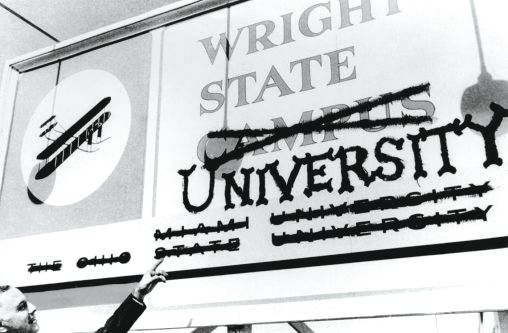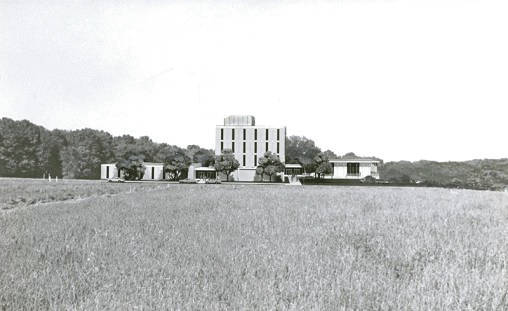

FAIRBORN — It was born in a pasture and in 50 short years has grown into a muscular, thriving center of higher education. Today, Wright State University boasts high-tech classrooms, state-of-the-art research labs, world-renown faculty, a mammoth arena, a fast-growing branch campus and national recognition for its service to the community, the military and students with disabilities.
Leading to the birth of Wright State was Ohio Gov. James Rhodes’ effort in the early 1960s to place public higher education facilities within 30 miles of every Ohioan.
At the time, Dayton was a high-technology center with a special need for a highly developed labor force. In 1962, community leaders mounted a private capital fund campaign to secure a joint branch campus for The Ohio State University and Miami University that could be converted into a unified state university.
The campaign included contributions from thousands of manufacturing employees in weekly or monthly payroll deductions. In just two months, more than $6 million in cash and pledges had been raised.
The four principal founders of the school were Novice Fawcett, president of Ohio State; John Millett, president of Miami and chancellor of the Ohio Board of Regents; Stanley Allyn, chief executive officer of the National Cash Register Corp. (NCR); and Robert Oelman, successor to Allyn at NCR and board chair of Wright State through its first decade.
The seeds for Wright State were planted in a pasture 12 miles northeast of downtown Dayton. The chosen site had plenty of room for expansion, highway access and was close to Wright-Patterson Air Force Base — a dream come true for Air Force planners hungering for a nearby university.
A man by the name of Henry Bader went from farm parcel to farm parcel, buying land totaling 428 acres at a cost of about $756,000. Groundbreaking occurred May 31, 1963 — a clear, bright day that had the musical instruments of the Air Force band sparkling in the sunlight.
Gary Barlow, a high school art teacher and one of the first faculty members at Wright State, remembers coming up to see where the university would be built.
“It was grassland and fences and cows in the fields and so on,” Barlow recalled. “I looked over and I thought, ‘Oh my, did I give up a job to come over here for this? Something isn’t even up yet.’ Later, I came out and watched the big hole in the ground being dug for the first building.”
When students arrived at Allyn Hall on Sept. 8, 1964, the Dayton Campus of Miami and the Ohio State University was educationally in business. The four-story structure housed classrooms, laboratories, administrative offices, a library, a bookstore, a lounge and a vending machine room. There was one parking lot.
It is said that the paint on the walls of Allyn Hall was still wet when classes began. Barlow said the first class he taught was in a classroom that was actually still under construction. He said he would teach a little and then stop so the construction workers could install ceiling tiles. Then he would start teaching again.
“I’d asked the class a question, and the worker up on top of the ladder raised his hand. So I called on him and he answered, and he got involved in the lecture in the class,” Barlow said. “Not many people have the opportunity of being there while a university is built around them. It’s really a wild and crazy and wonderful thing.”
There were few administrators, so faculty members had to solve problems among themselves, often holding brainstorming sessions during brown-bag lunches.
Everything wasn’t housed in Allyn Hall. The biology lab was in the upstairs bedroom of an old farmhouse. The chemistry department claimed the kitchen for its lab because it needed access to water and the large sink.
Students and others coming to campus for the first time and needing directions were sometimes told to keep an eye out for an exotic animal farm off of Colonel Glenn Highway and “make a left at the ostrich.”
In 1965, ground was broken for the science and engineering building, which would become Oelman Hall, and for the classroom-library building, which would become Millett Hall. Two years later, Fawcett Hall and a university center were completed.
When the school’s enrollment reached 5,000 students in 1967, it was christened as an independent university. Despite a campus suggestion box filled with proposed university names such as Southwestern Ohio State, Five Rivers, Tecumseh, Shawnee and GreeneMont, the school was named Wright State after the Wright brothers.
The Fish sisters — Gerry, Kathy, Betsy and Sue — perhaps best epitomized the young, fast-growing university. The sisters cut a high profile when they were at Wright State in the 1970s and were heavily involved in campus activities.
They were all in the same sorority — Kappa Delta Chi. Kathy, Betsy and Sue were cheerleaders for the Wright State soccer and basketball teams. The house they rented on Colonel Glenn Highway near the university became a magnet for fellow students. The sisters’ spaghetti dinners would draw the Wright State soccer team. Renowned artist Bing Davis once showed up bearing large institutional-sized cans of corn and beans.





